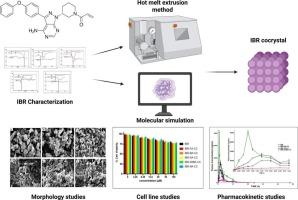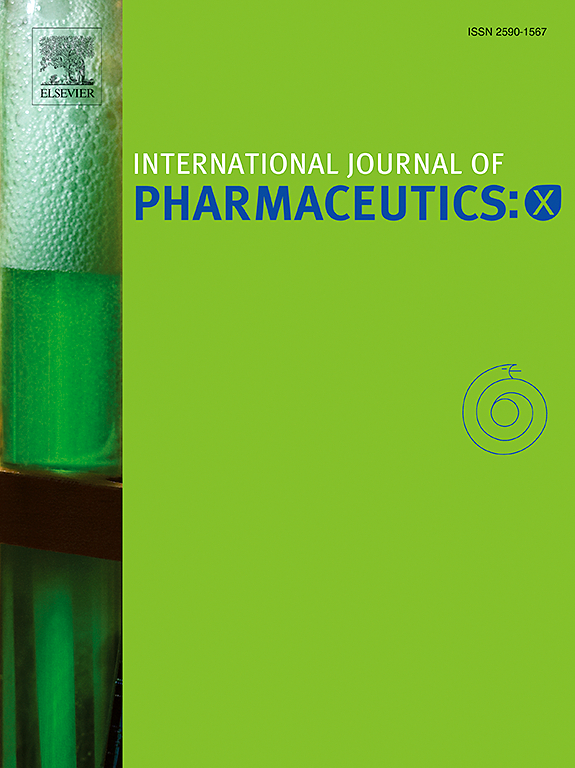依鲁替尼共晶的综合绿色合成和分子模拟,以提高生物制药性能和体内药代动力学
IF 6.4
2区 医学
Q1 PHARMACOLOGY & PHARMACY
引用次数: 0
摘要
布鲁顿酪氨酸激酶(BTK)抑制剂Ibrutinib (IBR)属于生物制药分类系统(BCS)的II类。CYP3A4酶迫使IBR具有非常有限的口服生物利用度。本研究采用热熔挤压法(HME)制备羧基和羧基酰胺共晶(IBR- cc)并对其进行表征。根据溶解度参数的计算评估和预测,选择了几种羧酸和羧基酰胺共构体来配制IBR-CC。计算结果表明,制备的IBR-CC体系具有多个氢键和π-π-堆积相互作用。进一步对IBR-CC制剂进行粉末溶出度研究、流动特性和体外释放研究。此外,与IBR相比,IBR- cc制剂在K562-CCL-243癌细胞中具有更好的抗癌作用。体内药代动力学评价研究证明,与纯IBR悬浮液相比,IBR-烟酰胺-共晶制剂IBR口服生物利用度提高4.58倍,IBR-富马酸-共晶制剂IBR口服生物利用度提高2.66倍,IBR-3-羟基苯甲酸提高1.76倍。生物分布研究表明,与纯IBR混悬液相比,IBR-烟酰胺-共晶制剂在肠道和其他淋巴器官中的药物释放量更大。因此,利用HME方法生产的IBR- cc制剂可作为一种有效的药物递送方法,提高IBR的溶解度和口服生物利用度。本文章由计算机程序翻译,如有差异,请以英文原文为准。

Integrative green synthesis and molecular simulation of ibrutinib cocrystals for enhanced biopharmaceutical performance and in vivo pharmacokinetics
Bruton's tyrosine kinase (BTK) inhibitor, Ibrutinib (IBR), belongs to class II of the Biopharmaceutics Classification System (BCS). CYP3A4 enzyme forces IBR to have a very limited oral bioavailability. This study employed hot-melt extrusion (HME) with carboxylic and carboxamide coformers, guided by computational screening, to prepare and characterize IBR cocrystals (IBR-CC). Several carboxylic acid and carboxyl amide coformers were chosen in accordance with computational evaluations and predictions for the solubility parameter to formulate IBR-CC. According to the computational results, the formulated IBR-CC systems had multiple hydrogen bonds and π-π-stacking interactions. The IBR-CC formulations were further evaluated for powder dissolution studies, flow properties, and in vitro release studies. Furthermore, IBR-CC formulations were correlated with better anticancer action in K562-CCL-243 cancer cells when compared with IBR. From the in vivo pharmacokinetic evaluation studies, it was proven that the IBR oral bioavailability in IBR-Nicotinamide-cocrystal formulation has shown a 4.58-fold improvement, IBR-Fumaric acid-cocrystal formulation has shown a 2.66-fold improvement, and IBR-3-Hydroxy benzoic acid has shown a 1.76-fold enhancement when compared with pure IBR suspension. Biodistribution studies showed greater drug release in the intestine and other lymphoid organs when administered with IBR-Nicotinamide-cocrystal formulation than pure IBR suspension. As a result, the IBR-CC formulations produced utilizing the HME approach serve as an effective method of drug delivery that increases IBR's solubility and oral bioavailability.
求助全文
通过发布文献求助,成功后即可免费获取论文全文。
去求助
来源期刊

International Journal of Pharmaceutics: X
Pharmacology, Toxicology and Pharmaceutics-Pharmaceutical Science
CiteScore
6.60
自引率
0.00%
发文量
32
审稿时长
24 days
期刊介绍:
International Journal of Pharmaceutics: X offers authors with high-quality research who want to publish in a gold open access journal the opportunity to make their work immediately, permanently, and freely accessible.
International Journal of Pharmaceutics: X authors will pay an article publishing charge (APC), have a choice of license options, and retain copyright. Please check the APC here. The journal is indexed in SCOPUS, PUBMED, PMC and DOAJ.
The International Journal of Pharmaceutics is the second most cited journal in the "Pharmacy & Pharmacology" category out of 358 journals, being the true home for pharmaceutical scientists concerned with the physical, chemical and biological properties of devices and delivery systems for drugs, vaccines and biologicals, including their design, manufacture and evaluation. This includes evaluation of the properties of drugs, excipients such as surfactants and polymers and novel materials. The journal has special sections on pharmaceutical nanotechnology and personalized medicines, and publishes research papers, reviews, commentaries and letters to the editor as well as special issues.
 求助内容:
求助内容: 应助结果提醒方式:
应助结果提醒方式:


